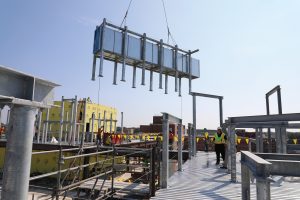Tech in Commercial Real Estate: Q&A with Jon Schultz
In an age where landlords are more like hoteliers, how can commercial real estate technology enhance the tenant experience? How is the pandemic shaping that experience? Real estate expert and early-stage seed investor in the CRE tech space, Jon Schultz, has spent the last 30 years of his career incorporating technology into his real estate assets, as well as his personal life. He’s the co-founder and managing principal of Onyx Equities, a top real estate firm in the New York metro market, and is a true thought leader when it comes to CRE tech adoption, business strategy, and commercial real estate.

Why have you dedicated your career to real estate and technology?
I like having an impact on everything I’m involved in. Through real estate, not only do I have the opportunity to learn about other businesses, but I’m able to impact them through the physical space they interact with every day. Technology makes that role even more exciting.
How do you determine whether a CRE technology platform is going to be successful?
Commercial real estate is my core business, so the technologies I invest in are usually experiments to make what we do better. That means I get involved in a lot of front-facing tech—technologies that are really going to help the tenants, our customers, be successful in their spaces. People are already entrenched in technology in their personal lives, so the goal is to give our customers that same feeling, just within the four walls of our building.
What is 5G and how will it impact the corporate real estate market?
Similar to 3G and 4G, 5G is the next-generation mobile network technology. It’s millimeter technology that won’t penetrate walls or glass, so we’re going to have to retool all of our facilities worldwide to utilize 5G. I think everyone is still trying to educate themselves at this point. As owners, we need to understand how to get the infrastructure ready for this. However, once it’s implemented, the speed and efficiency 5G will offer businesses is going to be game-changing.
What advice do you have for businesses trying to incorporate new technologies into their day-to-day operations?
I’m a firm believer in point solutions, mean-ing you examine your business’s biggest pain points and decide what you think is solvable over the next year. Once you decide on the problem and research a solution, you need to find the right early adopters within your organization who have the passion and energy to take it on. People don’t love to change, and integrating something new into your current processes usually creates more work upfront. It’s key you choose the right people to test the platform or software first and, if it’s successful, communicate it to the rest of your employees. It can’t be a top-down process—the adoption of new technology must be an “everyone-up” approach in order to succeed.
A current pain point that spans the entire construction industry is the shortage of skilled labor. Is that something technology might be able to address?
Millennials and Gen Z are going to make up over 50% of the workforce very soon, and the majority of those generations attended college, rather than trade schools. As skilled tradespeople start retiring, the industry is going to have to get creative in order to fill that gap, whether that means leaning on technology and robotics to automate certain processes, providing incentives for young people to enter the trades, or a combination of the two. Either way, I believe technology is going to play a huge role in helping the construction industry maintain the pace of work they’ve set over the last several decades.
How are you preparing your commercial buildings for the return of the workforce and is technology playing a role?
Safety has always been a top priority, but now we’re looking at safety through a health and wellness lens. We’re rethinking our cleaning processes, HVAC airflow, and air quality, and we’re implementing touchless technology solutions to reduce touchpoints. On top of that, we’re ironing out plans to make people aware of these changes and help them understand the new flow within our buildings.
How is the pandemic reshaping what people want from their physical workplace?
Right now, we’re all experiencing dramatic change—and it’s forced change. People have a completely different idea of what “work” looks like now than they did even six months ago. Our job as owners has always been to understand what people care about and be open-minded enough to deliver that experience. This global event is obviously pushing the needs and desires of our tenants in a certain direction, but the nature of what we do remains the same. We’re here to serve our customers, and today, that means listening to what is going to make them feel comfortable and safe in our spaces.
